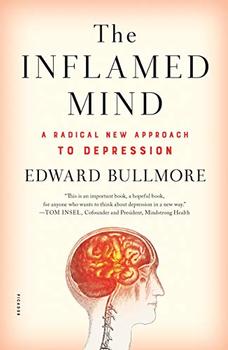Summary | Excerpt | Reviews | Beyond the Book | Readalikes | Genres & Themes | Author Bio

A Radical New Approach to Depression
by Edward Bullmore
What does an inflamed mind look like?
Mental inflammation, I used to think, without thinking about it too hard, might be similar to physical inflammation. As we have known since Roman times, the body becomes red and swollen when it is inflamed. So I used to imagine the inflamed mind was metaphorically red and swollen, angry and excessive, passionate, out of control and potentially dangerous, closest in psychiatric parlance to a state of mania. But the image of an inflamed mind that I conjure up now is almost the opposite: not a choleric and threatening person but a melancholic and withdrawn one. Like Mrs P, her hands swollen and deformed by inflammatory joint disease, silently wondering why she felt so gloomy and tired. I now think of her as typical of an inflamed mind, not metaphorically speaking, but mechanistically speaking.
The shift from metaphors to mechanisms of the inflamed mind begins by acknowledging the overwhelming evidence for a strong association between inflammation and depression. Simply recognising this association, which is sometimes hiding in plain sight, is the right place to start. But the crucial questions are about causality. For a new, post-dualist way of thinking to take root it must be scientifically established that inflammation is not merely associated or linked with depression but can directly cause depression.
One way of teasing apart cause and effect is by looking at the sequence of events in time. Causes must come before effects. So if inflammation is a cause of depressive symptoms, we would expect to find evidence that inflammation can occur before depression; and there is some such evidence from recent research. For example, a 2014 study of 15,000 children in Bristol and south-west England found that children who were not depressed, but were slightly inflamed at the age of nine, were significantly more likely to be depressed 10 years later as 18-year-olds. This is one of dozens of human studies, and hundreds of animal studies, that have shown that inflammation can anticipate or precede depression or depressive behaviours.
But precedence alone is not sufficient for inflammation to be taken seriously as a cause of depression. Sceptical scientists and doctors will need to know how, by what exact biological mechanisms, inflammation can cause depression, step by step from cytokines in the blood to changes in the brain that can in turn cause depressive changes in mood. Here too there is supportive evidence from recent experiments in animals and humans.
If a rat is experimentally injected with infectious bacteria, it behaves a bit like I did after the dentist. It withdraws from social contact with other animals, it doesn’t move so much, its sleeping and eating cycles are disturbed. In short, infection reliably causes a syndrome in animals – called sickness behaviour – that is roughly recognisable as akin to the human experience of depression. In fact, you don’t even need to infect a rat to see this sickness behaviour. It is enough to inject the rat with cytokines, proving that it is not the germ itself that causes sickness behaviour but the immune response to infection. Inflammation directly causes depression-like behaviours in animals – that is beyond doubt.3
We also understand how inflammation can have effects on the brains of rats and mice. We know that nerve cells exposed to cytokines are more likely to die and less likely to be regenerated. We know that when nerve cells are inflamed the connections or synapses between them are less capable of learning patterns of information and that inflammation reduces the supply of serotonin as a transmitter between nerve cells. For animals, at least, an explanatory chain is taking shape that can link inflammation of the body directly to changes in how nerve cells work in the brain, that in turn causes sickness behaviour that looks like depression.
To work out the equivalent chain of connections in humans is not easy. We can’t experimentally infect people with dangerous bacteria, we can’t inject cytokines (or anything else) directly into the brains of healthy people, and it is impossible to see what inflammation does to living human nerve cells, one cell at a time. The vast majority of human nerve cells – about 100 billion of them – are packed together densely in the brain; and the brain is extremely well protected from the outside world by the bony skull. The only way we can “see” what is going on inside the skull of a living human is with brain scanning techniques, like magnetic resonance imaging. And recent fMRI research has begun to produce evidence that inflammation of the body can have a direct causal effect on the human brain and mood. For example, when healthy young people were injected with a vaccine against typhoid, their immune systems reacted like the immune system of a rat injected with bacteria, and cytokine levels spiked in their blood. The vaccinated volunteers also became mildly depressed and their post-vaccination depression was associated with greater activation of regions of the brain that we know are hard-wired for emotional expression.
Excerpted from The Inflamed Mind by Edward Bullmore. Copyright © 2018 by Edward Bullmore. Excerpted by permission of Picador. All rights reserved. No part of this excerpt may be reproduced or reprinted without permission in writing from the publisher.
It is among the commonplaces of education that we often first cut off the living root and then try to replace its ...
Click Here to find out who said this, as well as discovering other famous literary quotes!
Your guide toexceptional books
BookBrowse seeks out and recommends the best in contemporary fiction and nonfiction—books that not only engage and entertain but also deepen our understanding of ourselves and the world around us.